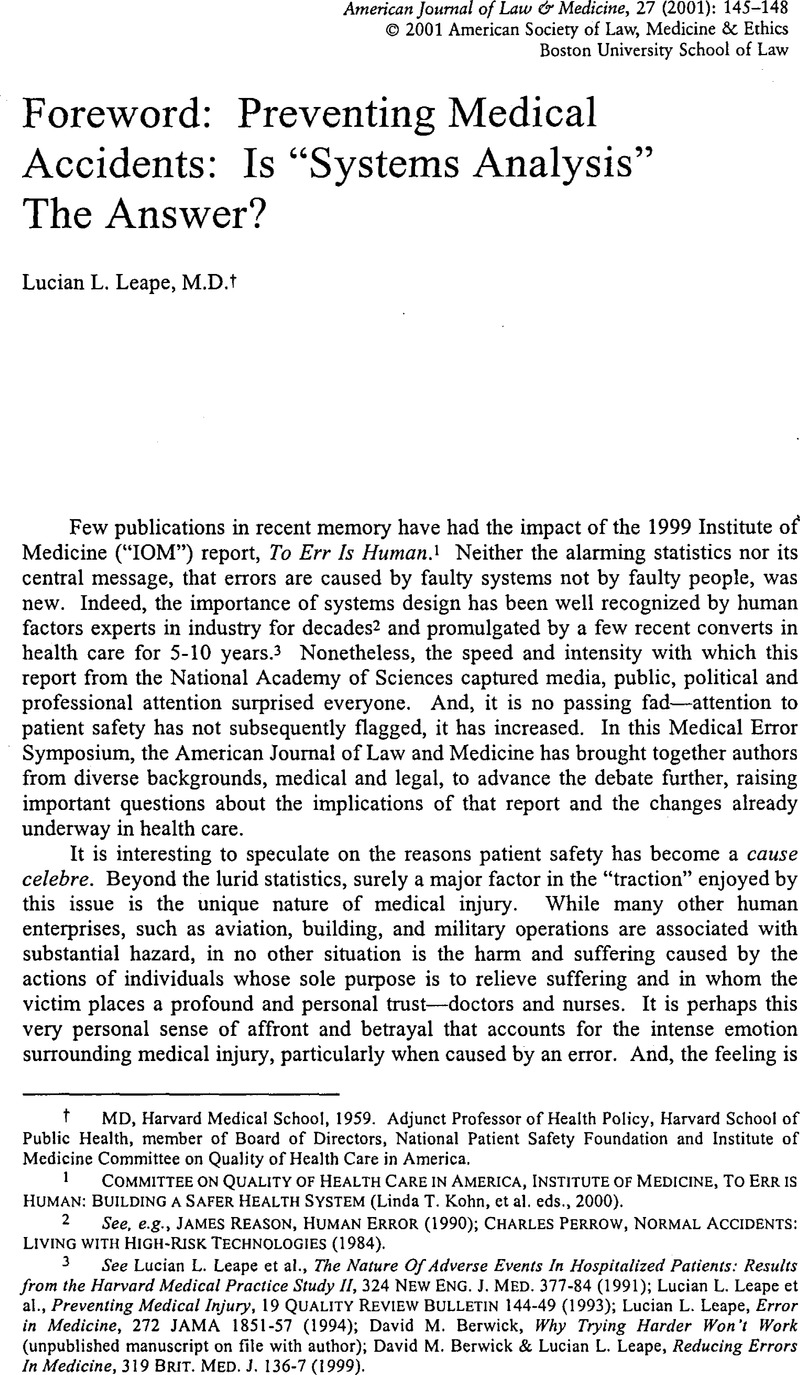Article contents
Foreword: Preventing Medical Accidents: Is “Systems Analysis” The Answer?
Published online by Cambridge University Press: 24 February 2021
Abstract

- Type
- Articles
- Information
- American Journal of Law & Medicine , Volume 27 , Issue 2-3: Perspectives on Medical Error: Reactions to the IOM Report , 2001 , pp. 145 - 148
- Copyright
- Copyright © American Society of Law, Medicine and Ethics and Boston University 2020
References
1 Committee on Quality of Health Care in America, Institute of Medicine, To Err is Human: Building A Safer Health System (Linda T. Kohn, et al. eds., 2000).
2 See, e.g., James Reason, Human Error (1990); Charles Perrow, Normal Accidents: Living with High-Risk Technologies (1984).
3 See Leape, Lucian L. et al., The Nature Of Adverse Events In Hospitalized Patients: Results from the Harvard Medical Practice Study II, 324 New Eng. J. Med. 377-84 (1991)CrossRefGoogle Scholar; Leape, Lucian L. et al., Preventing Medical Injury, 19 Quality Review Bulletin 144-49 (1993)CrossRefGoogle Scholar; Leape, Lucian L., Error in Medicine, 272 Jama 1851-57 (1994)CrossRefGoogle Scholar; David M. Berwick, Why Trying Harder Won't Work (unpublished manuscript on file with author); Berwick, David M. & Leape, Lucian L., Reducing Errors In Medicine, 319 Brit. Med. J. 136-7 (1999)CrossRefGoogle Scholar.
4 See, e.g., Bates, David W. et al., Incidence Of Adverse Drug Events And Potential Adverse Drug Events, 274 Jama 29-34 (1995)CrossRefGoogle Scholar; Gandhi, T. et al., Drug Complications in Outpatients, 15 J. Gen. Int. Med. 149-54 (2000)CrossRefGoogle Scholar; Jha, Ashish K., et al., Identifying Adverse Drug Events: Development Of A Computer-Based Monitor And Comparison To Chart Renvew, 5 J. Am. Med. Informatics Assoc. 305-14 (1998)CrossRefGoogle Scholar; Classen, David C. et al., Adverse Drug Events In Hospitalized Patients Excess Length Of Stay, Extra Costs, Attributable Mortality, 227 Jama 301-6 (1997)CrossRefGoogle Scholar.
5 See, e.g., Goldman, Lee et al., The Value Of The Autopsy In Three Medical Eras, 308 New Eng. J. Med. 1000-10005 (1983)CrossRefGoogle Scholar; Burton, Elizabeth C. et al., Autopsy Diagnoses Of Malignant Neoplasms: How Often Are Clinical Diagnoses Incorrect?, 280 Jama 1245-48 (1998)CrossRefGoogle Scholar.
6 See, e.g., Weeks, W.B. & Bagian, J.P., Developing A Culture Of Safely In The Veterans Health Administration, 3 Effective Clinical Practice 270-76 (2000)Google Scholar; Leape, Lucian L. et al., Promoting Patient Safety By Preventing Medical Error, 280 Jama 1444-47 (1998)CrossRefGoogle Scholar.
7 See, e.g., Vincent, Charles & Taylor-Adams, Sally, Framework For Analysing Risk And Safety In Clinical Medicine, 316 Brit. Med. J. 1154-57 (1998)CrossRefGoogle Scholar; Vincent, Charles et al., How To Investigate And Analyse Clinical Incidents: Clinical Risk Unit And Association Of Litigation And Risk Management Protocol, 320 Brit. Med. J. 777-81 (2000)CrossRefGoogle Scholar; Cook, How Complex Systems Fail 1-3 (1998); Cook, R., Human Error in The ICU 1-9 (1996)Google Scholar; Cook, R. & Woods, D., Medical Disasters And Latent System Failures: Blame, Guilt, And Causality 1-6 (1992)Google Scholar.
8 See Reason, James T., Managing The Risks of Organizational Accidents 252 (1997)Google Scholar.
9 See Mullan, Fitzhugh, A Founder Of Quality Assessment Encounters A Troubled System Firsthand, 20 Health Affairs 137-41 (2001)CrossRefGoogle Scholar.
- 9
- Cited by


